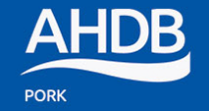Identifying Early Signs of Tail Biting
In this section of the WebHAT you will find information on early warning signs on your farm that can highlight that something such as ventilation, temperature, feed supply, nutrition etc is not quite right across the farm site. The majority of pigs may be able to tolerate the situation, but it is an early sign that individuals in some pens may turn to tail biting, indicating that the conditions are stressful for some pigs. A deterioration in the situation, eg temperature gets hotter (or colder) or another factor occurs (such as feed outage) may tip the rest of the pigs into tail biting.
Early prevention – things to look for
Awareness of these early cues that tail biting is about to happen can help with early actions to reduce tail biting. Reacting at this stage can help to prevent or reduce the impact of more severe biting activity later; once tail biting is established it is harder to manage or contain.
Scroll down to view a number of early signs associated with later tail biting behaviour, and things to look out for. Select the early signs which apply to your farm to add them to the report.
Pigs chewing on other pigs rather than straw or object
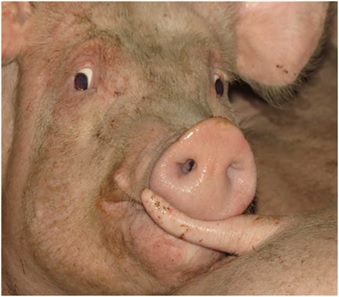
What to look for:
An objective measure of behaviour can achieved by observing the number of active pigs that are rooting or chewing straw or objects provided for enrichment and comparing against pigs rooting, chewing or biting/fighting other pigs. If more pigs are occupied with each other than with the straw or substrate provided then there is a higher risk of tail biting (ie pigs that are choosing to be active are not provided with a suitable rooting or chewing outlet). This quick visual assessment can be done at any time of day, and is very useful to gain an idea of where pigs are directing chewing behaviours. The number of pigs active is not as important as the ratio of active on enrichment to active on other pigs.
Agitated or Restless pigs
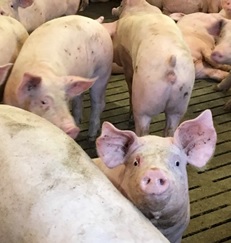
What to look for:
Be alert for groups/pens of pigs that are unsettled or restless, taking an unusually long time to settle following disturbance and milling around rather than lying down, a general impression that the pigs are rooting at or biting each other rather than objects provided, audible signs that the pigs are not settled, (eg squealing, fighting)5.
Also worth watching for unsettled individuals (eg one pig using enrichment when all others are resting, or one pig avoided by penmates), as these may indicate that they are not wholly content in the pen and may become tail biters even when the environment is suitable for the majority of pigs in the pen.
Tails tucked under
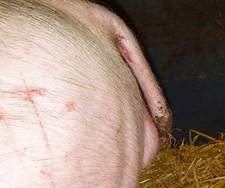
What to look for:
Be alert for pigs with tails tucked between their hind legs, or tails hanging straight down rather than curled. In docked pigs, look for tails pressed down and against the rump; this can indicate that the tail or tail end is painful or tender, possibly due to earlier chewing or attention by other pigs1.
“Guarded” tails can be most obvious when pigs are standing at the feeders, where tails may be most exposed, but can also be seen on pigs in general activity and interactions around the pen.
Tails hanging limply or tucked under are also linked to pigs that are ill, eg scouring, or pigs showing submissive behaviour, again suggesting pigs which may require additional attention and/or removing from mainstream pens - unwell pigs can easily become victims of tail biting as they are more reluctant (or less able) to move away from biting pigs.
Tails with no visible lesions may still have underlying bruising2, which may be the result of chewing or investigation by other pigs which has not yet broken the skin, but may if this continues. Once the skin is broken, the scent of blood can often trigger further investigation and chewing by other pigs.
Ear and Body Lesions
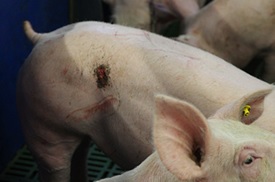
What to look for:
Presence of pigs in the pen with lesions on the body or ears indicates a high likelihood of tail biting. The higher the percentage of pigs per pen with body, ear or flank lesions, the higher the likelihood that tail biting lesions are also present.
The term “body lesions” is used here to refer to superficial scratches and scrapes on the surface of the skin, as well as deeper injuries.
“Ear lesions” refers to ear biting injuries, likely to be caused by fighting, or by ear chewing behaviour. These ear lesions are likely to be seen as fresh scratches and scrapes on the flap of the ear, or as chewing on the ventral edge of the ear.
Crusty lesions on the ear tip are more likely to be due to ear tip necrosis which has bacterial origin and requires remedial action. If pigs dislodge the scabs from necrotic ear tips, this may instigate ear chewing behaviour.
Body marks/lesions can also be caused by locomotor play in pigs – likely causes of body marks can be determined by observation of the pen and pigs’ demeanour and activity patterns.
No Risks Identified
You have not yet selected any risks and therefore don't appear to be at risk of tail biting, if you would like to browse all risks without building a report click here
Early Risks Identified
The early signs above that you have selected as present on your farm, indicate that pigs on your farm may be at risk of developing tail biting. Please click the button below that applies to you to look at more specific risks of tail biting
Pigs on straw
Without Substrate
Outdoor Finishers
Sub optimal staw
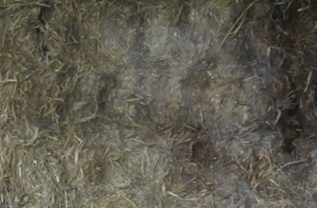
What to look for:
Straw provided for pigs should be clean and dry; straw which is excessively dusty or damp does not satisfy the pigs need for a clean dry lying area, and reduces straws properties as enrichment.
Look for:
- Dark or brown straw when freshly provided
- Check stored straw for dark, damp patches, mould or dustiness
- Check pigs in pens for coughing
Optimal straw provides the key properties needed for functional manipulable material for pigs, as well as the beneficial effects of thermal and physical comfort as bedding. When straw is suboptimal it has fewer of these properties and does not maintain the pigs’ interest as a source of manipulable material, and can also make conditions unpleasant in the pen, eg as a cold, damp lying area.
Low staw coverage
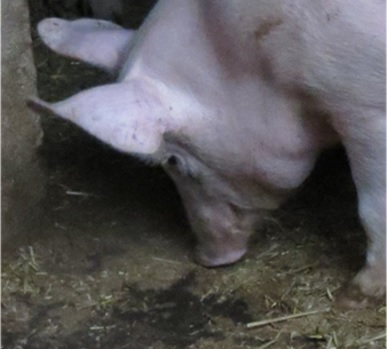
What to look for:
Less than 5cm depth of straw across the majority of the lying area.
Whilst straw covers all the requirements for pig enrichment and keeps pigs usefully occupied, it has additional benefits in providing a thermally and physically comfortable lying area. Providing low straw coverage will reduce pigs’ comfort when lying, and will disrupt resting behaviour. Low amounts of straw will restrict its availability to pigs as enrichment and may induce competition for comfortable lying areas and for straw as enrichment.
Change subtitle “Suggestions” to “Suggested Actions” and replace text under that heading with:
Aim to provide at least 5cm depth of straw across the majority of the lying area. Where pigs maintain clean straw, it can be topped up regularly, rather than replaced. If pigs regularly foul and waste straw, assess ventilation and lying patterns to ensure pigs are using the lying area as the dry, warm area of the pen; remove fouled straw.
Ensure that weekend workers have clear instructions on straw provision.
Cold pen temperature
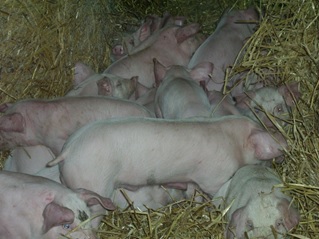
What to look for:
A priority is to ensure that pigs do not become too cold. There is a higher risk of tail biting occurring when pens are below the lower end of the recommended temperature range, than when temperatures are maintained at the upper end of the range4.
Defra recommend a temperature range for pork-weight pigs (~55kg) of 15 - 21°C, and for bacon weight pigs (~100kg) 13 - 18°C.
Shivering or huddling in pigs are signs of extreme cold which should clearly be avoided. However, pigs experience discomfort at milder temperatures than this without obvious outward signs.
Draughts in the lying area
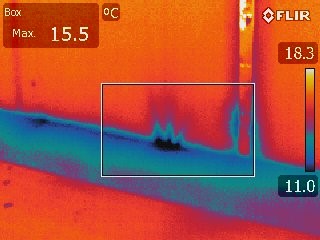
What to look for:
Look for visible signs of draughts such as patterns in the dust, movement of straw, pigs’ hair, etc, as well as checking detection of draughts while inside the pen, especially in the lying area. Look at lying pattern of pigs – are areas of the designated lying area avoided?
Cold air falling on to resting pigs will make them uncomfortable. Check that air from outside does not flow directly down walls and onto resting animals, particularly in cooler weather. The day and night resting patterns of the pigs’ should be observed (either directly, or by observation of dunging patterns when checking animals in the morning), as this can indicate the presence of draughts. Draughts will reduce the comfort of the lying area, and pigs may start to using avoid it. Intermittent draughts will disturb the resting behaviour of the pigs; causing discomfort and irritation as pigs end up lying on other pigs. Pigs becoming uncomfortable will in turn disturb resting animals.
Feed in pellets
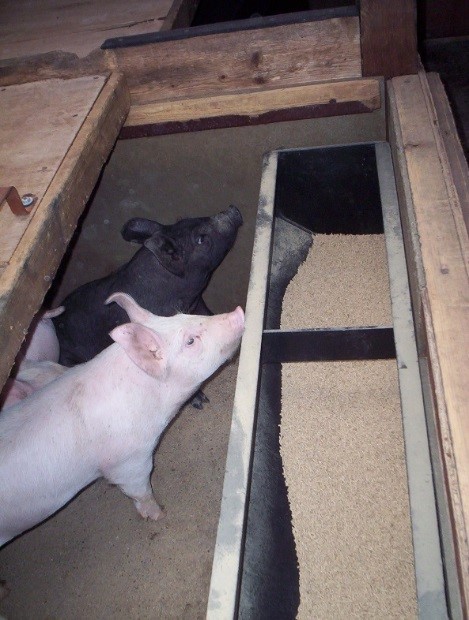
What to look for:
Is feed provided in pellet form?
Meal and liquid feed has been found to be associated with lower tail occurrences of tail biting than pelleted feeds6,7. This is considered to be due to pelleted feed being associated with gastric ulcers. The particle size within the pellets can be very small (less than 0.8mm) which has the potential to cause gut discomfort due to ulcers. Larger particle size is found in ground meal, which has a lower risk of gut ulcers.
Weight of pig
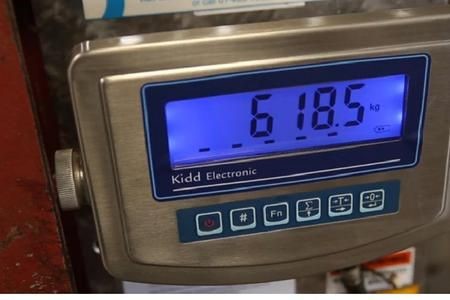
What to look for:
The risk of tail-biting lesions increases as pigs get older/heavier8. As pigs grow, they will impede movement of other pigs around the pen more than they did while smaller; there may also be a change from more juvenile playful behaviour and tolerance levels of other pigs to a less tolerant outlook which could include retaliation eg bites and fighting. There is also a suggestion that, as pigs become sexually mature, they may become more active and disruptive, which could affect behaviour.
While some tail damage will heal with time, in most instances tail lesions originate or get worse as a pig gets older (while still in mainstream pens). In finishers on straw, this confirms the general understanding that finisher-weight pigs are at higher risk of being tail bitten, rather than a flare-up of tail biting at a younger stage, which then recedes.
Humidity and temperature outside recommended range
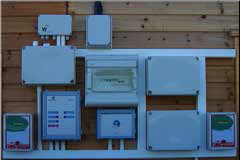
What to look for:
A priority is to ensure that pigs do not become too cold and damp. When the straw gets wet, it loses thermal properties and is no longer as good at insulating the pig from cold. Dung or urine in the lying area will also make the straw damp and less useful as insulation.
There is a higher risk of tail biting occurring when pens are below the lower end of the recommended temperature range, than when temperatures are maintained at the upper end of the range4. Watch out for shivering or huddling in pigs, which are signs of extreme cold, which should clearly be avoided. However, pigs experience discomfort at milder temperatures than this without obvious outward signs.
High number of hours of sunshine and High air pressure
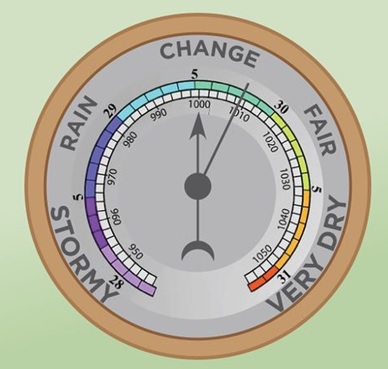
What to look for:
Likely to be observed as seasonal increases in tail biting in late summer, especially following an extended spell of sunny days with high air pressure (warm, still weather).
In straw units this increases the risk of tail biting, likely to be due to the weather conditions contributing to warm, humid conditions in the pens (where buildings have limited ventilation options).
Fouled Drinkers
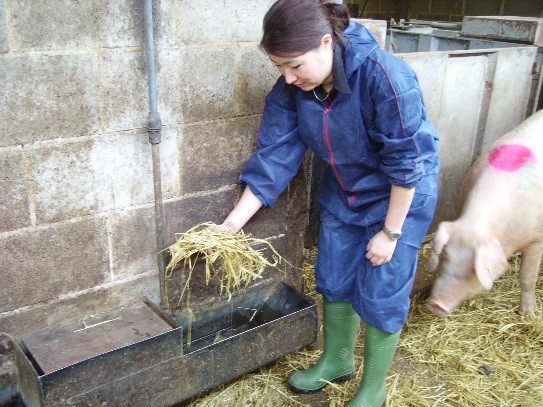
What to look for:
Presence of fouled straw or dung within bowl drinkers, or dung caked around nipple drinkers. Fouled drinkers could reduce pigs’ water uptake, and could increase competition for preferred drinkers. As well as this, presence of fouled drinkers may indicate problems in daily care and management of the animals.
Not using PCV2 vaccine
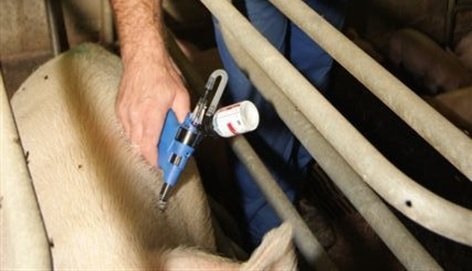
What to look for:
Check via producer / supplier or own records whether all pigs have been vaccinated using a PCV 2 vaccine.
Significantly lower levels of tail biting has found on units following introduction of PCV 2 vaccines8,9. The vaccination against porcine respiratory viruses and improving health in general, may be beneficial in improving pigs’ tolerance to other stressors in the environment.
Pens are long and narrow
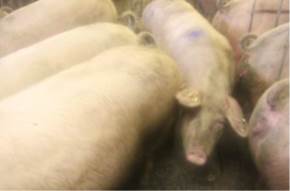
What to look for:
Look for pens which are long and narrow rectangles, or where the lying area is long and narrow, as this pen layout can restrict the passage of pigs through the pen. Pigs wanting to get between lying area, water, feed and dunging areas in such pens are more likely to disturb other pigs. This is more of a problem where the passage of pigs across the pen or lying area is impeded, especially where the position of the drinkers, feeders and dunging area encourage pigs to walk through the lying area11. When pigs are standing at a feeder or drinkers, check if there enough room for other pigs to pass easily behind them.
Objects at floor level, fouled or indestructible
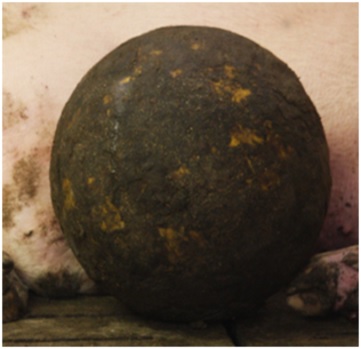
What to look for:
Provision of objects in strawed pens is often a reaction to existing tail biting, hence finding objects in pens with tail biting in.
Where objects are provided for enrichment, these should be suspended from the pen walls to help keep the objects clean and in use. Pigs maintain interest in clean objects which are destructible or deformable, rather than solid metal or objects that are too large to chew or bite. Indestructible objects on the floor that have become fouled will not encourage interaction with the pigs. Providing objects in this way can also be a sign of reaction to tail biting, rather than using enrichment objects as preventative measures.
Mix of tail lengths
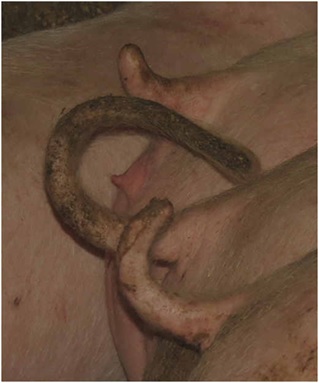
What to look for:
Tail biting is more likely in pens where pigs have a mix of tail lengths – either a mix of docked and undocked tails, or a mix of docked tail lengths (eg some at 1/3 docked length, some at 2/3 docked length). Also look for batches/pens where there may be an occasional undocked pig among otherwise docked animals.
A mix of tail lengths is likely to stimulate the interest of pigs because of the novelty of the different lengths and movements of the tail. As well as this, mixed tail lengths can highlight a number of possible management issues:
- Where management procedures at weekends, such as docking, are different to weekday routine and care
- Runty piglets (often left undocked to minimise stress) may be more likely to become tail biters
- Different docking opinions and techniques by stockpeople
- Inconsistent use of docking equipment, or difficulties using docking equipment
- Mixing of previously separate groups (e.g. from different source farms or buildings)
- Mixing of pigs intended to be breeding gilts back into mainstream finishing
Pigs which have previously been housed on straw, now in non-straw housing

What to look for:
Be aware of the previous housing systems pigs have been reared in. Pigs moved from straw housing to non-straw housing have a higher risk of developing tail biting and, therefore, need more careful management to help reduce the risks of tail biting12. If all rearing stages are not on this unit, check with the producer what housing system the pigs are from.
Pigs which have been previously housed on straw are likely to have developed a stronger behaviour pattern of rooting and chewing; and it therefore becomes even more important that they are provided with good quality and quantity of substrates and objects to chew and root on13. When housed without substrate there is a higher risk of other pigs becoming targets of chewing (eg ear and tail biting), so it becomes even more important to provide the pigs with good quality and quantity of enrichment.
Season - Late summer
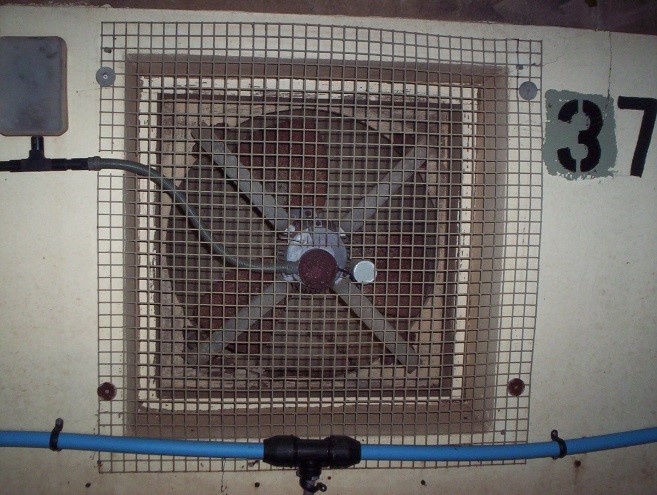
What to look for:
Higher tail biting is likely in artificially ventilated buildings in late summer.
Not all units will have a seasonal pattern, but collecting and recording information on the number of tail-bitten pigs per month (or per week) can help to show whether this is a risk on a particular unit.
Be aware of weather and season contributing to tail biting – the increased risk of tail biting in late summer is linked to pens/buildings becoming too hot and humid, for example, where the ventilation settings are not circulating air adequately, or where change in wind direction affects ventilation patterns.
High Temperature
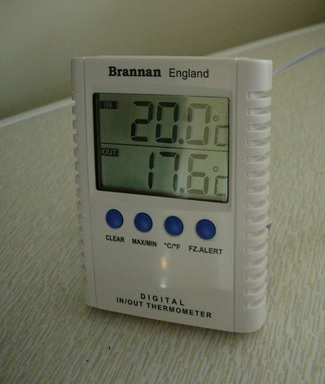
What to look for:
Avoid temperatures at the high end of or exceeding the Defra recommendations (a temperature range for pork-weight pigs (~55kg) of 15 - 21°C, and for bacon weight pigs (~100kg) 13 - 18°C). Measure and record at close to pig height inside pens).
Signs of high temperature include:
- Pigs being unsettled (looking for a cool lying area away from the body heat of other pigs)
- Pigs lying far apart
- Pigs lying (by choice) in the dunging area or under the drinkers
- Pigs being very dirty (from lying in the dunging area or dunging in the lying area)
- Pigs dunging on the solid lying area (in order to lie on cooler slatted area).
- Increased water consumption & wastage
- Panting
- Skin discolouration
In artificially ventilated systems, high temperatures are likely to combine with high humidity, making the environment uncomfortable for the pigs. High temperature and high humidity together are more hazardous than when they occur separately. In slatted systems, pigs have limited opportunities to cool down when the environment is hot, so require more careful building management such as ventilation.
High humidity

What to look for:
Avoid high humidity, above 60%.
If no humidity meter is available, likely indicators of high humidity are similar to high temperature. Additional signs would be where paperwork etc in the building becomes damp. In cold outdoor temperatures, extremely high humidity will be visible as fog or mist when entering the building.
Fouled or dirty objects in the pen
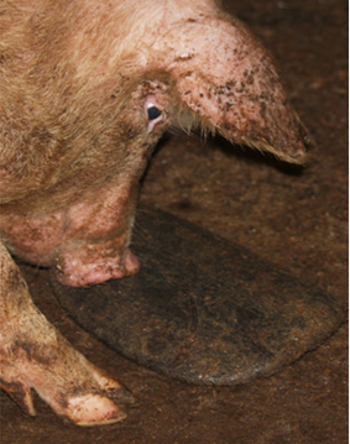
What to look for:
Objects broken off chains, or detached objects which are or have been in the dunging area (large percentage of the surface covered in muck).
Where objects are provided for enrichment, these should be suspended from the pen walls to help keep the objects clean and in use. Pigs maintain interest in clean objects which are destructible or deformable, rather than solid metal or objects that are too large to chew or bite. Indestructible objects on the floor that have become fouled will not encourage interaction with the pigs. Providing objects in this way can also be a sign of reaction to tail biting, rather than using enrichment objects as preventative measures.
Mix of tail lengths

What to look for:
Tail biting is more likely in pens where pigs have a mix of tail lengths – either a mix of docked and undocked tails, or a mix of docked tail lengths (eg some at 1/3 docked length, some at 2/3 docked length). Also look for batches/pens where there may be an occasional undocked pig among otherwise docked animals.
A mix of tail lengths is likely to stimulate the interest of pigs because of the novelty of the different lengths and movements of the tail. As well as this, mixed tail lengths can highlight a number of possible management issues:
- Where management procedures at weekends, such as docking, are different to weekday routine and care
- Runty piglets (often left undocked to minimise stress) may be more likely to become tail biters
- Different docking opinions and techniques by stockpeople
- Inconsistent use of docking equipment, or difficulties using docking equipment
- Mixing of previously separate groups (e.g. from different source farms or buildings)
- Mixing of pigs intended to be breeding gilts back into mainstream finishing
Not using PCV2 vaccine

What to look for:
Check via producer / supplier or own records whether all pigs have been vaccinated using a PCV 2 vaccine.
Significantly lower levels of tail biting has found on units following introduction of PCV 2 vaccines8,9. The vaccination against porcine respiratory viruses and improving health in general, may be beneficial in improving pigs’ tolerance to other stressors in the environment.
Dunging in the lying area
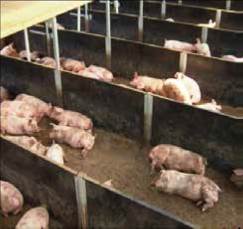
What to look for:
Pigs appearing dirty, presence of dung or urine in the lying area.
This suggests that the ventilation pattern does not match the pigs’ preferred behaviour pattern or pen layout (eg position of feeders and drinkers). If the ventilation system is not able to maintain a comfortable temperature and humidity in the lying area, pigs may choose to lie in the cooler dunging area. This then makes it more likely that they will dung in the previous lying area.
This pattern may also induce unsettled or irritable behaviour in the pigs as their resting behaviour is constantly disturbed.
Alternately, dung in the lying area can suggest that the dunging area is too small, or that pigs are trying to dung away from the feeders. It can also suggest that the dunging area is being avoided by the pigs, e.g. strong ammonia, or rain and wind.
Pens are long and narrow
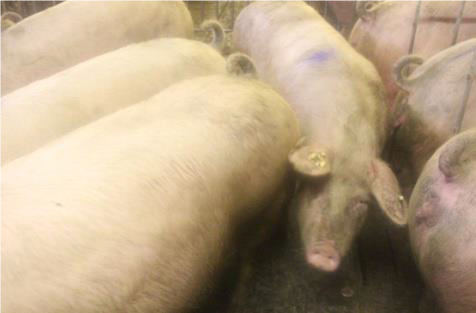
What to look for:
Look for pens which are long and narrow rectangles, or where the lying area is long and narrow, as this pen layout can restrict the passage of pigs through the pen. Pigs wanting to get between lying area, water, feed and dunging areas in such pens are more likely to disturb other pigs. This is more of a problem where the passage of pigs across the pen or lying area is impeded, especially where the position of the drinkers, feeders and dunging area encourage pigs to walk through the lying area11. When pigs are standing at a feeder or drinkers, check if there enough room for other pigs to pass easily behind them.
Pen Layout

What to look for:
Look at the pen usage by the pigs – are the dunging area, drinkers and feeders at or near one end of the pen, or are pigs having to cross the lying area to get between them? Are pigs in the lying area being disturbed by pigs trying to access the feeders?
Pigs habitually wake from resting, go to defecate, eat, drink then return to resting. If they have to walk through the resting area to do this, they are likely to disturb pigs that are trying to rest.
If the pigs are resting in the dunging area this suggests that the building or pen ventilation is not creating the best patterns of cool and warm air for the pigs.
Pen layouts where the lying area obstructs pigs moving between dunging area, feeders and drinkers, especially if pen shape is long and narrow, which can restrict pig movement further.
Health

What to look for:
Check via producer / supplier or own records whether all pigs have been vaccinated using a PCV 2 vaccine.
Significantly lower levels of tail biting has found on units following introduction of PCV 2 vaccines8,9. The vaccination against porcine respiratory viruses and improving health in general, may be beneficial in improving pigs’ tolerance to other stressors in the environment.
Genetics
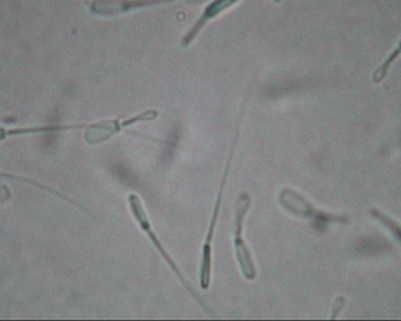
What to look for:
Check records of tail-biting occurrences. Do they tie up with the introduction of new stock sources or bloodlines?
New breed combinations or genetic lines may not be as well adapted for the outdoor systems as previous supplies and may struggle to cope. Pigs may be less well adapted for weather extremes, or may be less well adapted to standard outdoor diet.
Ventilation and thermal comfort
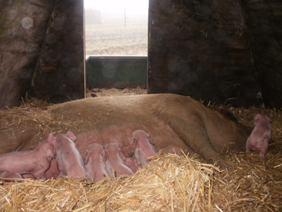
What to look for:
Enter the shelters/arks regularly to check what the environment is like. Check:
- If the shelter ark is very humid
- Has high ammonia
- Is very cold or hot
- Are pigs huddling together?
- Is straw in lying area very dark and damp?
- Are pigs lying on their sides, far apart, or not lying inside the building?
Whilst outdoor pigs have a greater choice of environments, they still need a warm, dry lying area and protection from cold, wet conditions and draughts as well as a protected shelter from high temperatures and sunburn. Pigs in naturally ventilated systems (eg large, open barns) are at higher risk of tail biting in cold damp conditions.
Extreme Weather
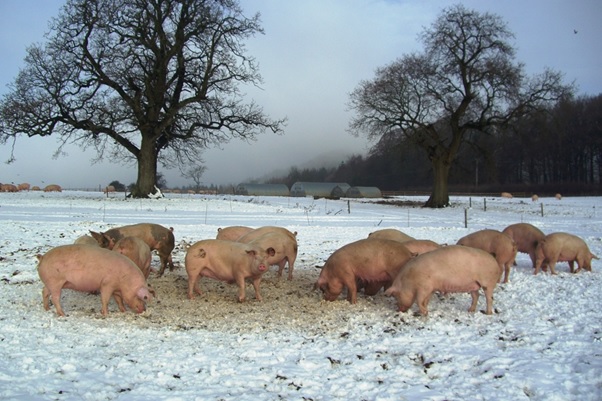
What to look for:
Extreme weather poses the main challenges to outdoor pig welfare – rain, wind, hot and low temperatures, mud, ice, etc.
Limited feed and water access
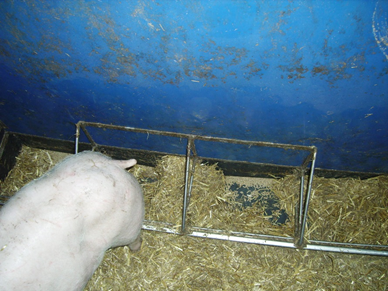
What to look for:
Look for pigs squabbling at feeders or drinkers, or disquiet.
Feed and water are still important resources for outdoor pigs. Competition at feeders and drinkers will not only result in less even growth, but also increases the risk of tail biting being used as a way to access these resources.
Inadequate Enrichment

What to look for:
Look out for a low proportion of pigs rooting around in soil or straw compared with proportion rooting or chewing on fittings in the paddock (posts, pipes, etc.) or interacting agonistically with other pigs (eg chewing on ears or tails, fighting – interacting in a way that gets a negative reaction from the other pig such as walking away, squealing or retaliating).
Outdoor systems are generally considered to provide the most natural rooting and chewing opportunities for pigs, eg turf, soil, insects, stones, as well as a greater range of temperatures, choice of environments, light levels, etc. However, especially in paddocks where pigs have been regularly housed, the “interest” in soil may be reduced, eg if soil is dry or dusty, or has high percentage of faeces.
There is still no definitive interpretation of the use of pebbles by outdoor pigs and whether or not stone chewing is a sign of good or poor conditions. Tooth and stomach damage have been attributed to stone chewing (even if pigs are choosing to use the stones as enrichment) – provision of less harmful enrichment materials that fulfil more of the pigs’ needs is likely to be more beneficial.
Stray Voltage
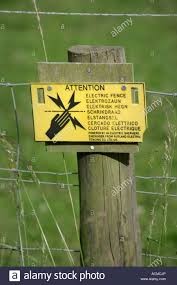
What to look for:
Observe pigs around the paddocks. Are they cautious to approach fittings they should be familiar with, eg feeders and drinkers? Are pigs startled by contact with shelter sides or other fittings?
Stray voltage around the paddock can result in the pigs receiving shocks or unpleasant sensations from various pen fittings, eg drinkers, feeders, shelter sides.
